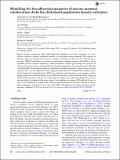Files in this item
Modelling the broadband propagation of marine mammal echolocation clicks for click-based population density estimates
Item metadata
| dc.contributor.author | von Benda-Beckmann, Alexander | |
| dc.contributor.author | Thomas, Leonard Joseph | |
| dc.contributor.author | Tyack, Peter Lloyd | |
| dc.contributor.author | Ainslie, Michael | |
| dc.date.accessioned | 2018-08-13T23:33:32Z | |
| dc.date.available | 2018-08-13T23:33:32Z | |
| dc.date.issued | 2018-02 | |
| dc.identifier | 252173117 | |
| dc.identifier | 8864ba56-72d9-48c9-a977-faf859954c0d | |
| dc.identifier | 85042168801 | |
| dc.identifier | 000424994000044 | |
| dc.identifier.citation | von Benda-Beckmann , A , Thomas , L J , Tyack , P L & Ainslie , M 2018 , ' Modelling the broadband propagation of marine mammal echolocation clicks for click-based population density estimates ' , Journal of the Acoustical Society of America , vol. 143 , no. 2 , pp. 954-967 . https://doi.org/10.1121/1.5023220 | en |
| dc.identifier.issn | 0001-4966 | |
| dc.identifier.other | ORCID: /0000-0002-7436-067X/work/42276810 | |
| dc.identifier.other | ORCID: /0000-0002-8409-4790/work/60887966 | |
| dc.identifier.uri | https://hdl.handle.net/10023/15815 | |
| dc.description | Funding: U.S. Office of Naval Research (ONR Grant No. N00014-14-1-0409); P.L.T. acknowledges funding received from the MASTS pooling initiative (The Marine Alliance for Science and Technology for Scotland). MASTS is funded by the Scottish Funding Council (Grant No. HR09011) and contributing institutions. | en |
| dc.description.abstract | Passive acoustic monitoring with widely-dispersed hydrophones has been suggested as a cost-effective method to monitor population densities of echolocating marine mammals. This requires an estimate of the area around each receiver over which vocalizations are detected—the “effective detection area” (EDA). In the absence of auxiliary measurements enabling estimation of the EDA, it can be modelled instead. Common simplifying model assumptions include approximating the spectrum of clicks by flat energy spectra, and neglecting the frequency-dependence of sound absorption within the click bandwidth (narrowband assumption), rendering the problem amenable to solution using the sonar equation. Here, it is investigated how these approximations affect the estimated EDA and their potential for biasing the estimated density. EDA was estimated using the passive sonar equation, and by applying detectors to simulated clicks injected into measurements of background noise. By comparing model predictions made using these two approaches for different spectral energy distributions of echolocation clicks, but identical click source energy level and detector settings, EDA differed by up to a factor of 2 for Blainville's beaked whales. Both methods predicted relative density bias due to narrowband assumptions ranged from 5% to more than 100%, depending on the species, detector settings, and noise conditions. | |
| dc.format.extent | 1377873 | |
| dc.language.iso | eng | |
| dc.relation.ispartof | Journal of the Acoustical Society of America | en |
| dc.subject | QA Mathematics | en |
| dc.subject | QH301 Biology | en |
| dc.subject | NDAS | en |
| dc.subject | SDG 14 - Life Below Water | en |
| dc.subject.lcc | QA | en |
| dc.subject.lcc | QH301 | en |
| dc.title | Modelling the broadband propagation of marine mammal echolocation clicks for click-based population density estimates | en |
| dc.type | Journal article | en |
| dc.contributor.sponsor | Office of Naval Research | en |
| dc.contributor.institution | University of St Andrews. School of Mathematics and Statistics | en |
| dc.contributor.institution | University of St Andrews. Marine Alliance for Science & Technology Scotland | en |
| dc.contributor.institution | University of St Andrews. Centre for Research into Ecological & Environmental Modelling | en |
| dc.contributor.institution | University of St Andrews. School of Biology | en |
| dc.contributor.institution | University of St Andrews. Centre for Social Learning & Cognitive Evolution | en |
| dc.contributor.institution | University of St Andrews. Sea Mammal Research Unit | en |
| dc.contributor.institution | University of St Andrews. Sound Tags Group | en |
| dc.contributor.institution | University of St Andrews. Bioacoustics group | en |
| dc.contributor.institution | University of St Andrews. Scottish Oceans Institute | en |
| dc.identifier.doi | https://doi.org/10.1121/1.5023220 | |
| dc.description.status | Peer reviewed | en |
| dc.date.embargoedUntil | 2018-08-14 | |
| dc.identifier.grantnumber | N00014-14-1-0396 | en |
This item appears in the following Collection(s)
Items in the St Andrews Research Repository are protected by copyright, with all rights reserved, unless otherwise indicated.

